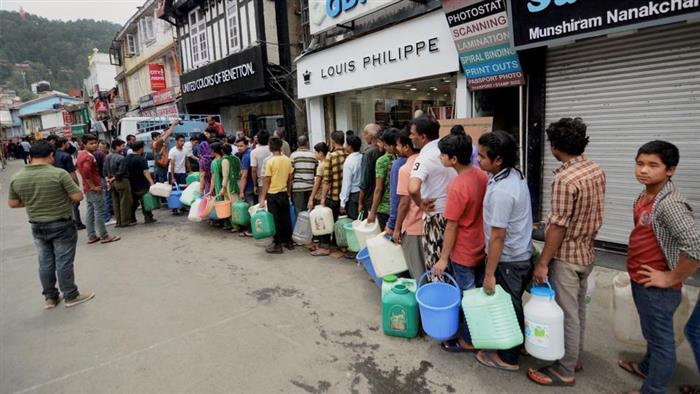Asia Times
HIMANSHU THAKKAR

If you love Shimla, please do not visit.” That is the message going viral on Indian social media ahead of the peak tourist season in the hill city, as its 170,000 residents grapple with a deepening water crisis.
So serious is the threat that people in the state of Himachal Pradesh are calling Shimla the Cape Town of Hills, in reference to Zero Day in Cape Town, when the South African city’s water supply was expected to be exhausted. Cape Town eventually avoided that fate.
Having no water is a bad advertisement for a hill station that depends on tourists for most of its revenues. And with the peak holiday season just about to hit, the smart thing would have been to anticipate the problem and take pre-emptive action.
But not in Shimla. It seems the city is not just facing a crisis of water supplies, but also one of governance and management that is linked to environmental issues. The Shimla High Court pointed out these issues and recommended a series of measures to tackle them; it may be a bit late, but one can only hope that it ensures these are implemented.
The most recent water crisis possibly began with events that occurred in the winter of 2015, when Shimla faced a huge outbreak of hepatitis due to pollution in the Ashwini Khad — a river valley that supplies significant amounts of water to the city.
Thousands became infected and dozens of people died. It was found that the poorly functioning Malyana Sewage Treatment Plant was releasing effluent into the Ashwini Khad, and water supplies from the valley were reduced. But no steps have been taken to fix the plant and restore the flows. Now the Himachal Pradesh Chief Secretary has said that water from Giri and Gumma streams has also been reduced.
Deeper issues have contributed to Shimla’s worsening water situation, including unplanned growth in the hill station, degradation of the catchments for its water sources — including deforestation and blasting — destruction and pollution of springs and streams in the hills, climate changes and complete inattention to local situations.
The city’s groundwater recharge, the process where water filters down from the surface and enters aquifers, is continuously decreasing, while groundwater use is increasing at unsustainable rates. This leaves the city without the fallback position it enjoyed in earlier water crises.
Hydropower projects have contributed to environmental damage all across Himachal Pradesh by causing deforestation. Tunneling, blasting and muck dumping have also created catchment degradation, changed micro climates, caused landslides and dried up rivers.
The Himachal ecology that sustained the region by so long by soaking, storing and slowly releasing the rainwater is no longer able to perform that role due to the multiple adverse impacts of hydropower projects and other construction onslaughts.
As is the case in most cities, the water tanker business — most of which relies on groundwater for its supplies to users — is flourishing in Shimla. But such unregulated use of groundwater could have many implications, including an adverse impact on freshwater springs, which are a major water source in all Himalayan states, including Himachal Pradesh in general and Shimla in particular.
A recent United Nations Development Program report noted that “discharges of 500 water supply sources, including springs, streams, ponds etc had reportedly reduced by more than 50%” in Uttarakhand state. It is essential to conduct similar assessments of the state of springs in all Himalayan states, including Himachal Pradesh.
The snowfall was more than 50% lower than usual in most parts of the Himalayas this winter. Temperatures are usually rising by this time of year, melting snow and glaciers, and increasing water flows in the rivers and streams. This summer a series of weather events, including storms, led to significant rainfall in the northern plains and a drop in temperatures that reduced the snow and glacier melt. The March-May rainfall was 28% below average in Shimla.
The resultant water flow in the Himalayan streams is so low that the Bhakra Beas Management Board, which oversees the Bhakra and Pong dam reservoirs, called a series of emergency meetings and reduced water releases to Punjab, Haryana and Rajasthan.
With Shimla being in the same catchment, flow in the rivers that it depends upon were also reduced; water availability declined to an unprecedented 18 million liters per day (MLD). The city’s requirements in summer go as high as 45 MLD.
The water footprint of India’s urban sector is increasing by leaps and bounds, not only in terms of demand and sourcing of water, but also with the liquid and solid effluent it generates. Yet, the sector operates in a complete policy vacuum. There is no urban water policy in India.
Given the lack of policies, any crisis like the one facing Shimla will automatically lead to proposals for new “mega projects”. For example, a massive, centralized, high-cost and high-impact World Bank-funded project to source water from Kol Dam on Sutlej River is being pushed to solve Shimla’s water problem. But it will likely create more problems for the city, instead of providing a sustainable solution.
There is also the need to assess Shimla’s capacity to absorb tourists and construction, to ensure that the influx of both remains within certain limits. We may have a lot to learn from Bhutan in this context.
Shimla needs a comprehensive package of policies that takes stock of the city’s local resources, including rainfall, catchments and streams, that ensures the recycling of sewage at decentralized treatment plants, plugs significant transmission and distribution losses and stops the wasteful and destructive use of the available resources. The city’s water infrastructure has been designed for a much lower population and needs upgrading. With climate change impacts becoming more apparent, water crises will become more frequent and intense in the years to come, yet we remain completely ill-prepared to face them. In fact, we are inviting greater trouble and deeper crises with the damage we are wrecking on our ecosystems in the name of growth and urbanisation.
Shimla, where it has long been apparent something would go wrong, shows how authorities have remained totally unprepared, and how we are not getting any “smarter” at managing our cities.




